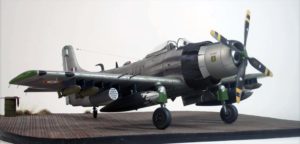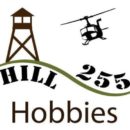 Sadly, despite the length, breadth and unprecedented color of a career unrivalled by any other aircraft in history, so far as the world of scale modeling is concerned, my favorite subject remains little better than a pathetic side show afterthought. Partisan I may well be, as a modeler however I am nonetheless on thoroughly objective ground observing the old girl has not been handled by the industry in any manner at all worthy of her historic presence and accomplishments.
Sadly, despite the length, breadth and unprecedented color of a career unrivalled by any other aircraft in history, so far as the world of scale modeling is concerned, my favorite subject remains little better than a pathetic side show afterthought. Partisan I may well be, as a modeler however I am nonetheless on thoroughly objective ground observing the old girl has not been handled by the industry in any manner at all worthy of her historic presence and accomplishments.
This approach is likewise evident, alas, in many of my esteemed fellow practitioners of the craft; the legions of balding fat guys who will erect guillotines and light torches over misplacement of a single panel line on the latest of ten thousand iterations of some Hakenkreuz festooned Schmetterling. Workbenches are pounded to kindling, basements trashed, empty pizza boxes hurled wholesale into outer darkness, the eternal heavens cursed and censorious fur balls hawked vis-à-vis “questionable depiction” of the odd Horikoshi designed fuel filler cap…convention city ER’s and ICU’s routinely schedule extra staff to deal with the inevitable floodtide of “erroneous shade of PC-10” induced cerebrovascular accidents and MI's while the nightmares of hardened cops and EMTs are forever haunted by visions of portly Hawaiian shirt, shorts and sandal clad bodies hurtling headlong from hotel ramparts in paroxysms of “inappropriate weathering” mass suicide.
Oh, the humanity.
Yet, oddly, this same bunch will readily roll over and show their bellies for any sort of preposterously tooled and haphazardly researched schlock labeled “Skyraider” with astoundingly incongruous sanguinity. Go figure; they ask no questions, make no comments but instead throw some glue and paint its way, imagine nonsense under the wings, slather on some bumble-lightning cliché and proudly showcase the result which will be grandiloquently pronounced by all and sundry as “bien joué”.
Whoever said life was fair?
Where to start?
Let’s begin by examining the possibilities arrayed before any model builder who determines he or she would like to “build a Skyraider”.
The range of options becomes evident via a quick perusal of the following chart I created beginning with some very well catalogued information from a Wikipedia article I ran across some time back. (https://en.wikipedia.org/wiki/Douglas_A-1_Skyraider )
Listed are, I believe, pretty much all of the AD/A-1 variants produced in El Segundo along with a few aspects of their assorted configurations. Where an asterisk (*) appears I have corrected what my research indicates to be errors or I have refined and/or supplemented some of the information listed there. I also cleared up a few misspellings.
| MODEL | DETIALS AND CHARACTERISTICS |
| XBT2D-1 | Single-seat dive-bomber, torpedo-bomber prototype for the U.S. Navy. 25 built* |
| XBT2D-1N | Three-seat night attack prototypes; only three aircraft built. |
| XBT2D-1P | Photographic reconnaissance prototype; only one built. |
| XBT2D-1Q | Two-seat electronic countermeasures prototype; one aircraft only. |
| BT2D-2 (XAD-2) | Upgraded attack aircraft; one prototype only. |
| AD-1 | The first production attack bomber model*; 242 built |
| AD-1Q | Two-seat electronic countermeasures version of the AD-1; 35 built. |
| AD-1U | AD-1 with radar countermeasures and tow target equipment, no armament and no water injection equipment. |
| XAD-1W | Three-seat airborne early warning prototype. One aircraft only.* |
| AD-2 | Improved attack model*, powered by 2,700 hp (2,000 kW) Wright R-3350-26W engine; redesigned and improved canopy.* 156 built. |
| AD-2D | Unofficial designation for AD-2s used as remote-control aircraft, to collect and gather radioactive material in the air after nuclear tests. |
| AD-2Q | Two-seat electronic countermeasures version of the AD-2; 21 built. |
| AD-2QU | AD-2 with radar countermeasures and target towing equipment, no armament and no water injection equipment; one aircraft only |
| XAD-2 | Similar to XBT2D-1 except engine, increased fuel capacity |
| AD-3 | Stronger fuselage, improved Aero Products propeller, improved landing gear, tailwheel configuration to final form. * 125 built |
| AD-3S | Anti-submarine warfare model; only two prototypes were built |
| AD-3N | Three-seat night attack version; 15 built. |
| AD-3Q | Electronic countermeasures version, countermeasures equipment relocated for better crew comfort; 23 built. |
| AD-3QU | Target towing aircraft, but most were delivered as the AD-3Q |
| AD-3W | Airborne early warning version; 31 built. |
| XAD-3E | AD-3W modified for ASW with Aero Products propeller |
| AD-4 | Strengthened landing gear, improved radar, G-2 compass, anti-G suit provisions, 20 mm M-3 cannon added to outer wings for a total of four on last 128 built. Upgraded to final single seat canopy design incorporating large armored windscreen, notched lower rudder profile*; 372 manufactured. |
| AD-4B (A-1D)* | Specialized version designed to carry nuclear weapons, also armed with four 20 mm M-3* cannon; 165 built plus 28 conversions. First model incorporating internal cowling baffle flap system, Aero 4B long chord rocket launchers and external aluminum armor standard on production line; (all often retrofit to earlier marks)* |
| AD-4L | Equipped for winter operations in Korea; 63 conversions |
| AD-4N | Three-seat night attack version; 307 built |
| AD-4NA* | AD-4N with night fighter electronic equipment removed and used primarily as an attack bomber. Many subsequently served with French Forces in Africa.* |
| AD-4NL | Winterized version of the AD-4N; 36 conversions. |
| AD-4Q | Two-seat electronic countermeasures version of the AD-4; 39 built |
| AD-4W | Three-seat airborne early warning version; 168 built. A total of 50 AD-4Ws were transferred to the Royal Navy as Skyraider AEW Mk 1. Note: windshield reverted to rounded AD-2/3 profile with modified canopy hood to match.* |
| AD-5 (A-1E) | Two seat side by side “wide body” configuration; fuselage side dive brakes deleted*. 212 built. |
| AD-5N | Four-seat night attack version, with radar countermeasures*; 239 built |
| A-1G | Former AD-5N airframes fitted with duel controls, new wiring, a different radio suite and often Yankee extraction escape systems for USAF/VNAF service in Vietnam |
| AD-5Q (EA-1F) | Four-seat electronic countermeasures version; 54 conversion |
| AD-5S | One prototype to test MAD anti-submarine equipment. |
| AD-5U | The AD-5 when modified for target towing became UA-1E in 1962. The same model converted as a transport was sometimes referred to as AD-5R |
| AD-5W (EA-1E) | Three-seat airborne early warning version with an AN/APS-20 radar installed; 218 were built. |
| UA-1E | Utility version of the AD-5 |
| AD-6 (A-1H) | Single-seat attack aircraft with three dive brakes, centerline station stressed for 3,500 lb (1,600 kg) of ordnance, 30 in (760 mm) in diameter, combination 14 in (360 mm) and 30 in (760 mm) bomb ejector and low/high altitude bomb director; 713 built. |
| AD-7 (A-1J) | The final production model, powered by a R-3350-26WB engine, with structural improvements to increase wing fatigue life; 72 built. Most fit with Yankee extraction escape systems for USAF use. |
Why do I say unlike the mind numbing array of Spitfires, Mustangs, Zeros, Bf-109s et al produced, what afterthought efforts the industry has tossed out Skyraider-wise has been abysmal? Look at the colors in the cells above. Black colored listings are what they are; some short lived prototypes or conversions which only amounted to a few airframes, some items refer to versions of the Skyraider which served in some capacity in the Korean War or in post Korea Navy service.
The salient point is the red blocks. This color indicates all the marks which can be built from the parts provided in any available, not to say decent kit on the market as of this writing. Except for the AD-4B (A-1D) these versions saw service from only about 1958 onward and combat only in Vietnam or in one of the micro-wars afterwards.
Not much red up there, is there? In fact, over the decades only five worthwhile kits have ever emerged from the primordial ooze of the international kit manufacturing industry as all the while we flounder in an incalculable plethora of 109’s, Mustangs, Spitfires and Phantoms.
Just five, and, yes, in my time I have built, or attempted to build, just about every single offering in plastic, resin and wood going back to several runs at the 1958 Jurassic Revell 1/40 scale Franken-toy kit of my youth. (See the Kit Review Section)
…And defenestrated the vast majority. My experience has been, not to put too fine a point on it, almost every Skyraider-esque eyesore inflicted upon us has been so poorly shaped and/or researched as to be thoroughly beyond hope for any modeler wishing to merely empty a box and thereby add an even halfway accurate example to their collection.
Unhappily this pretty much describes the lay of the land as of this writing.
This might be somewhat understandable if the AD/A-1 series was an obscure or less historically significant subject. With all due respect, however, the airplane’s history, service adaptability, combat record, lists of firsts, lasts, “onlys” and broad spectrum effectiveness far and away eclipses all of those listed above, and many more, combined.
Less understandable yet is even this parsimonious offering has only ever allowed us a paltry three possibilities if we want to work anywhere near out of the box.
Moreover, two of this trio was provided solely via Paul Fisher’s exquisite 1/32 conversion sets for wide body AD-5/A-1E/G and AEW-1 variants. These resin beauties were the only hope we have had to date in any scale of a worthwhile kit version of family model Skyraiders. Sadly, due the 2018 Paradise fires in California and the tragic loss of Paul’s home and shop, (but thankfully not of Paul himself) they are no longer manufactured.
So, then, minus the Fisher treasures, we are left with only three fairly decent representative kits. The good news is there is one in each of the primary scales; the bad news is they are, as the chart above indicates, all late version single seat attack variants only.
This means if you happen to fancy a “straight” late 1950’s-to late 1960’s Navy or Marine gray/white AD-6 (A-1H) or AD-7 (A-1J), or perhaps a Vietnam War VNAF or USAF A-1H/J, you’re good to go.
Beyond this, if anything else on the chart above trips your trigger and you’re not into careful research, alterations, and substitutions; if you’re not good at or do not enjoy scratch building, then it pretty much sucks to be you. Or me. One of the reasons for this site is to illustrate 1) other versions can be produced if we want one bad enough and 2) a couple of ways in which we may go about it.
In a subsequent blog, I will discuss the particularities involved in modeling any version of the Skyraider which served in the Korean War. Until then build long and prosper.

